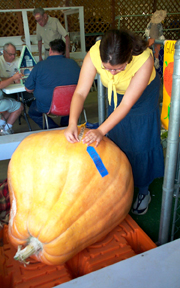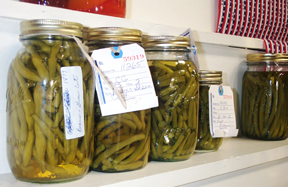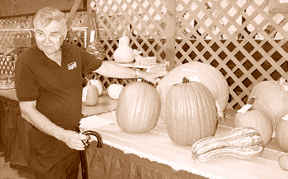
|
 Who’s The Fairest Of Them All? Who’s The Fairest Of Them All?
by Kimberly Goode and Sandra Martin
photos by Kimberly Goode
Even if you’ve never won a thing in your life, you can be a champion.
Winning doesn’t take speed, strength or agility. You don’t have to be Lance Armstrong, Julia Child or Carl Lewis.
You can gather armloads of white, red and blue ribbons at your county fair. Nearly everything you make, bake, can, collect, grow, sew, paint or photograph has a place at the county fair. This year’s Anne Arundel County Fair, which we visited, closed last week, but there’s still time to enter in the Calvert County Fair, which opens next week.
Pumpkins, Peaches, Red Peppers and Swine
County fairs are harvest festivals. Whatever else you do — and there’s plenty, from spinning on carnival rides, to stuffing yourself on cotton candy and boardwalk fries, to competing as a Daisy Duke look-alike, to cheering on giant tractors pulling monumental loads — the main attractions rise from farm and field.
Heavy-weight horses compete with tractors to pull the greatest load. Steers, sheep and swine, goats, rabbits and chickens show off their breed’s best qualities and their owners’ loving attentions. You can call a hog and sometimes a husband, or bury your face in pie because, yes, county fairs really do have pie-eating contests.
As well as livestock on the hoof, there’s produce in the barn.
Record-breaking pumpkins set you wondering how anything could grow so large. At the other end of the scale, a mini-bottle gourd almost disappears beneath its ribbon. Honey mirrors the colors of beer. Glass jars of peaches, peppers, pickles and asparagus look too good to eat. Berry pies appeal and blue-ribbon cakes tantalize, but you’ll never taste them. That’s a job for the judges.
These wonders and more make their five-day home in county fairs’ arts and crafts hall, where — as we watch — everyday champions are winning glory.
Bringing in the Sheaves
Monday of fair week, canners, bakers, painters, garden growers and candle makers descend on arts and crafts halls with boxes, baskets and truck beds full of their wares. Fair booklets — the bible of county fair faithful — list dozens of categories, prescribing down to the smallest detail the standards hopeful winners must follow. No matter how beautiful your jar or how ample your pumpkin, if it’s in the wrong category, it won’t win.
 As Anne Arundel County canning judge Nancy Wolfe advises one sure-to-be disappointed entrant, “this one is beautiful, but the booklet says no half-gallon jars.” As Anne Arundel County canning judge Nancy Wolfe advises one sure-to-be disappointed entrant, “this one is beautiful, but the booklet says no half-gallon jars.”
Among vegetables, you can enter everything from asparagus to zucchini in 19 main categories with dozens of variations.
Among fruits, there’s everything from apples (keep the stems on, please, judge Dick Angus admonishes) to nuts. Chestnuts, both American and Chinese, found their way to the Anne Arundel County Fair.
Honeys run from light amber to dark molasses.
Cookies drip with confectionery sugar and cakes with enticing icing, but they’re only for show, not to eat. Bakers show their wares in 10 many-divided categories.
Ranged in shining, summer-bright jars are pickles, peppers, peaches, pears, plums and persimmon butter — plus plenty of fruits and vegetables that don’t begin with P.
Among the men, women and children bringing their goods to the fair, hopes are as high as their baskets are full. For each of those hundreds of categories, will award a blue ribbon for first, a red for second and a white for third place — plus rosettes for champions and best in show winners. Along with each ribbon comes a few dollars, but it’s glory rather than cash these competitors long for.
“It’s such a surprise to win. You don’t enter to win, but it’s still a thrill. I love the competition of it all, and that’s what it’s really about: the community and the people,” said best-in-show winner Marie Gish of Odenton. “What’s really neat is to watch first-time entrants win. Some people actually cry and carry on. It’s a lot of fun.”
For the five days of a fair, friends, family and all comers will see their glory, a bright ribbon affixed to their prize-winning effort.
But first come the judges.
 |
Volunteer Debbie Overstreet, opposite, tapes a blue ribbon to the 389-pound great pumpkin at the Anne Arundel County Fair.
Vegetable judge Richard Angus, above, compares smaller Connecticut field pumpkins. A larger Big Max waits its turn in the background. |
Let the Judging Begin
Tuesday of fair week, the judges appear. Clipboards in hand and pencils at the ready, they stroll through each exhibit comparing and contrasting. Some categories have a single judge, while others have up to six. Pros in the art they judge and often trained in the ways of judging, they come to the fair to rule on quality, consistency, conformity and creativity.
Who are these men and women who choose the fairest of them all?
At Home Among Pumpkins
Richard Angus is at home among the pumpkins. From a 4-H kid who learned how to till the earth on his family’s farm in Minnesota to a Peace Corps agricultural volunteer in Uruguay to a many-year member of the National 4-H Judging Team at the University of Maryland, Angus has dedicated his life to vegetables and to improving the skills of the people who grow them. So when he says a pumpkin’s in the wrong class, Connecticut field pumpkins and even Big Maxes jump to attention.
Anne Arundel County Fair vegetable chairwoman Carol Overstreet dispatches her daughter and helper, Debbie, to the rescue.
Soon every pumpkin stands properly placed.
Or lies, as the case may be.
By their nature, Connecticut field pumpkins stand upright. “They’re long and tall and should be symmetrical, not lopsided, and unblemished,” says Angus, eyeing two of the species. He sees in a glance that one captures the ideal while the other falls short. The lesser pumpkin is lopsided, and its rich, deep orange mottles to melted Dreamsicle on one side.
Big Max pumpkins, on the other hand, lie about their natal fields, so these mellow gold masses are likely to have a bad side. To win a prize, the farmer who tends a Big Max will have to labor in the fields, turning the growing pumpkin to avoid blemishes.
There was no turning the Big Max in competition for Anne Arundel County’s biggest pumpkin. It tipped the scales at 190 pounds — but it didn’t come near to taking the prize. This year’s champion, a giant apricot dumpling grown by Robert Dunlap of Harwood, weighed in at a mighty 389 pounds, almost 100 pounds bigger than last year’s champion.
How do you stimulate a pumpkin to grow into a giant? “I understand they put a stake in and feed them milk,” says Angus, whose credentials also include a quarter-century of judging at the Montgomery County Fair and training would-be vegetable judges under the auspices of the Maryland State Fair.
Corn and cantaloupe, garlic and gourds, pumpkins and potatoes, tomatoes and tomatillos, Dick Angus has judged them all. There’s nothing he’d like better than to judge yours next year. What’s more, he’ll add a tip or two to the tag that identifies each entry.
“Keep the stems on the apples,” he advised Mike Sundquist of Harwood, whose plate of red delicious apples took a blue ribbon despite this glaring fault. Angus would have placed them second, but their uniformity, quality and conformity to the standard of their variety were too good to be overlooked.
It could have been you winning those prizes. It can be you next week — if you bring the best from your garden to the Calvert County fair.
Championing Pickles
The fruits and vegetables judged by Dick Angus flourish for a few short days. The sparkling jars in the realm of canning co-chairs Karlene Zepp and Sherry Gunther keep the summer of ’03 bright for months, even years, to come.
 |
| Canning judge Nancy Wolfe considers the virtues of a pint of cherries. |
Canning summer’s bounty used to be a survival skill. You could still call it that if you’re grappling with the abundance of a garden gone wild, but many home canners now consider their work akin to quilting: an art that satisfies in the doing and in the keeping. There’s another reward the two home arts have in common: They preserve you against whatever winter may bring. Those satisfactions may explain why canning is as often a self-taught art as one passed down by mothers and grandmothers.
Anne Arundel County Judge Nancy Wolfe of Chaptico knew home canning, but her mother’s main product was tomatoes, including fried green tomatoes. “The family ate them for Christmas breakfast,” says Wolfe. “They were more like stewed tomatoes.” No wonder, since canning involves creating a heat-induced vacuum in the jar, which for many products takes long boiling.
Because of fruitful cherry and fig trees, Wolfe branched out from her family tradition into jellies, jam and pickles. Now, she says, “my fig pickles almost always win a first, and if I’m going to get a championship, it will be for those pickles.”
After achieving mastery in the kitchen, Wolfe learned judging first from Sherry Gunther, who, with her daughter, is co-chair of canning at this fair. Next, she studied at the judging school sponsored by the Maryland State Fair. Judges are certified after three classes.
Wolfe’s home fair is St. Mary’s County, and she often enters Charles and Calvert county competitions, too. In most counties, you don’t have to be a resident to enter. Of course you can’t compete and judge in the same fair. So Wolfe judges farther afield, which brings her to Anne Arundel County’s 2003 fair.
“This jar has a nice appearance, but the fruit rose to the top,” she judges, considering a quart of artfully stacked nectarine halves. “But on these pears, she got it just right,” says the judge, considering a nearly identical jar of white fruit. Judging is blind, with the maker’s name tucked into a fold of the label. But in this case workmanship and handwriting reveal that both jars are the work of the same hands.
With fruit and vegetables her territory this year, Wolfe does her judging by sight and not by taste. Carelessness or bad luck can make a jar go bad, and judges take no chances. Down the canning aisle, jelly, jam, preserve and pickle judges taste as well as look. The high content of sugar in the one case and vinegar in the other keep the products from going bad.
Five judges are at work this year, but the shelves are not filled.
“Next year we would love to see more people enter. Just remember, folks, the more you enter, the more you can win. More entries mean more money and more ribbons,” advises canning co-chair Karlene Zepp.
Sweet as Honey
Much like beer, honey runs in color from light amber to deep stout. Color is determined by its floral source. Hereabouts, lighter honeys come from black locust, which blooms in May and June. Making darker honeys, bees sample more tulip poplar and clover.
Judge Dave Morris adjusts a light honey jar in his polariscope. The light is not hitting the jar correctly, so he moves the glass. “Now, see how you can see the crystals,” he says.
Peering at the honey jar, you can indeed see these crystals as tiny specks floating inside the jar. They look like small stars spanning the night skyline.
Crystals count to Morris, who has judged fair honey for eight years. He’s also current president of the Bowie/Upper Marlboro Bee Keepers Association and former president of the Maryland State Bee Keepers Association.
Consistency counts, too. “It’s important for a judge to be consistent,” he says. “If I rate crystals in one jar as a seven, then I should be able to pick up another jar that was rated a seven and the crystals should match.” Moisture of the honey and the jar’s cleanliness, are also rated. Believe it or not, taste is not.
 |
Accounting for Taste
Like three bees swarming a comb of sweet honey, Judy Carter and her troop of volunteers busily sample breads and sweets. For six judges of Anne Arundel County Fair’s baking category, this is serious business. Two judges taste cakes, two candies and two breads. Taking a breather, Carter explains that “what we look for in the baked goods competition is taste first.”
Each competitor brings a product big enough for the judges to taste. “Of course we love it when they bring extra, because the volunteers get to taste, too,” Carter laughs.
The most experienced of the judges can, she says, “take a bite of a cookie and tell you all the ingredients.” Judges also look for texture and doneness.
Carter is a woman happy in her work. Shelves are full, and so is she by the time her judging round takes her to cakes elaborately decorated purely for show. The dummy cake competition is reserved for professionals who cannot win the highest honor, Best in Show. Champions don’t rise on looks alone.
 |
| Judging fine arts are educator Dennis Younger above, and portrait painter Phyllis above left. |
Art for All Seasons
They don’t until you get to the corner where Phyllis Avedon and Dennis Younger are judging. There, champions indeed rise on looks alone.
Fine arts don’t need to be anything but what they are. They don’t have to taste good, meet a crystalline standard, stand no bigger than a quart-size jar or conform to any ideal but their own. It’s art for art’s sake that has lured Avedon to the Anne Arundel County Fair from her studio at Maryland Hall for the Creative Arts, where she paints portraits that sell for thousands of dollars.
“What I look for is the creative spark,” says Avedon, who returns to the fair year after year to have her own eye sparked by the fire of these amateurs.
While Avedon judges mature art, Dennis Younger judges younger art. Among vibrant color — pinks, purples, blues and yellows — he strides, hands clasped behind his back and brow knitted in concentration. Examining each brush stroke and pencil shading of young people, Younger is in his element. Art and children have centered a life that includes two decades as the executive director of curriculum for Anne Arundel County schools and many years on the board of Maryland Hall for the Creative Arts, nine as president.
“I thought this year’s exhibit was just wonderful,” says Younger, who prizes originality, movement and color. “It’s so nice to see great artwork from all ages. It’s a wonderful experience that I enjoy every year.”
See 8 Days a Week for the pleasures of the Calvert County Fair. You’ve still got time to win ribbons there this year, with entries for most arts, crafts and garden and kitchen due Monday, September 22: 410/535-0026.
|
|

